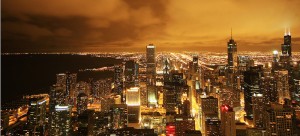
It’s not the streets of Los Angeles or New York that make people nervous anymore. The majority of Americans now believe Chicago to be the most dangerous city in the country, according to recent data.
Earlier this month, research and consulting group YouGov published a poll that shows 53 percent of Americans believe Chicago to be unsafe. A mere 33 percent of those surveyed identified the city as safe.
The research also indicated that people believe Chicago’s crime rate is increasing, despite the city’s decreased homicide and shooting rates over the last two decades.
“I don’t feel like the perception is accurate,” said DePaul University freshman Matt Rushing. Originally from Schaumburg, a Chicago suburb, Rushing said he’s always felt safe walking in all parts of Chicago. “I think the media kind of blows it out of proportion by focusing on the negative things.”
A recent report from the Pew Research Center shows that for Chicago’s population of 2.7 million, the rate is unsurprising. Scaling murder rates in cities that had 100,000 or more people, Chicago is ranked 21st with a rate 18.5 murders per 100,000 people in 2012. Compare those numbers with those of Flint, Michigan, which had 62 murders per 100,000 people in the same year.
Rushing agrees with the Pew data saying the most dangerous city most likely lies in Michigan.
“The most dangerous city? Probably Detroit,” Rushing said. “You always need to be aware and keep your guard up. In Chicago it’s not like that.”
Why the perception?
Because DePaul’s Loop and Lincoln Park campuses lie in some of the safest Chicago Police Districts, students feel secure walking around the university, said Bob Wachowski, DePaul’s director of public safety.
The Loop is in District 1 and Lincoln Park in District 18. Both record some of the lowest crime statistics in the city.
“The shootings we so often hear about are actually miles away from campus,” Wachowski said.
The Public Safety Department also holds numerous prevention programs to hear concerns and offer suggestions as to how to stay safe on campus.
Miles Harvey, an assistant professor in DePaul’s English department, feels the perception runs deeper than violence, and at its root is a race and segregation issue.
“We are such a segregated city and cut off from each other,” Harvey said. “Most of these killings happen in a limited area of the west and south sides…We can get by without paying attention, but we shouldn’t.”
In 2011 and 2012, as part of a class assignment, Harvey asked students to go out and talk to people affected by violence in Chicago.
Their findings were produced in the book “How Long Will I Cry: Voices of Youth Violence.” Harvey hopes the book will help get the conversation of violence moving, leading to more productive action.
“It (has) given people a means of talking about violence. There’s kind of a taboo despite the amount of violence in this city,” Harvey said.
Mostly, Harvey feels Chicagoans and Americans should worry less about the perception of its city and focus more on actual statistics and how to improve safety rates.
“The mayor spends too much money to alter perceptions rather (than) actually altering the problem. When we get better policing and more attention in these neighborhoods, better perceptions will follow,” Harvey said.

